Have you become interested in gardening? Then here are some handy tips and various common shrubs chart, that will help in shrubs and bushes identification...
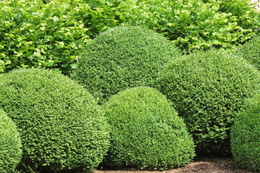
Different shrubs and bushes are used for different purposes. Most popular are evergreen bushes, which provide a green foliage throughout the year. Then there are deciduous shrubs and bushes which provide a great fall foliage, which makes them popular among cultivars. Then there are everyone's favorite the flowering plant bushes, which produce beautiful blooms of various colors during the spring and fill up the garden with beautiful fragrance. Certain flowering bushes, produce cherries throughout a season, which adds up to their value. Also, some people like to plant tree shrubs in their landscapes. If you want to learn how to distinguish between these shrubs and bushes, then here are various shrubs and bushes identification chart and tips that will help.
Chart for Identification of Shrubs and Bushes
Carrying a hand book, some pencils, a camera and importantly a good horticulture guidebook with you, can greatly help you while trying to identify the various shrubs and bushes. This way you can take pictures, carry leaves of a certain bush with you for identification, and study these species of plant even at home. Here is a chart of the common shrubs and bushes, which you can refer to for identifying shrubs and bushes.
To view the images better, click on the thumbnail pictures to open larger pictures.
Common Name
Scientific Name
Attributes
Picture
White Butterfly Bush
Buddleia davidii 'Alba'
This bush grows 5 feet tall and 5 feet wide. It shows panicles of fragrant white flowers that have orange ends on the branches from the mid summer till mid of fall. It has grayish green foliage throughout the season, and has fuzzy narrow leaves. This bush attracts butterflies.
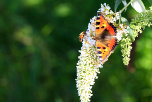
Purple Butterfly Bush
Buddleia davidii
These bushes get beautiful purple blooms, and have dark gray-green leaves which are large. The flower heads are of 6-8" with beautiful fragrance, these bushes attract butterflies, hummingbirds and other beneficial insects.
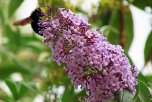
Red Twig Dogwood
Cornus alba 'Elegantissima.'
This bush grows to a height of 8', and 8' width. It bears variegated leaves, which are greenish gray with a white edge, and has small white flowers which together form a flat cluster. The flowers then transform into berries which are white with hints of blue and green. During fall, it will get a rose or gold foliage.
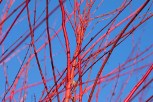
Common White Lilac
Syringa Vulgaris
Lilac bush is a beautiful and fragrant deciduous shrub, and can be used as a hedge. It gets white flowers in clusters and has dark green leaves which are heart-shaped.
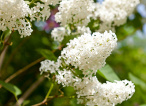
Aphrodite Rose of Sharon
Hibiscus syriacus
This is a deciduous shrub, which has a green foliage and long-lasting flowers which can be rosy-pink in color. It grows to a height of 10 feet tall and 6 feet wide. It's funnel-shaped blooms resemble tropical hibiscus plant.
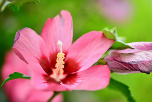
Daphne Laurel
Daphne laureola
This evergreen shrub forms a plant, which looks like a small tree of 2-4 feet tall. It's leaves are densely whorled near the top of the stem, and are very dark green, shiny and smooth. The twigs have a stout odor when they are cut, and the flowers are small and grow in clusters of 2-10.
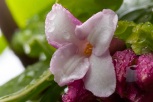
Mountain Laurel
Kalmia latifolia
For mountain laurel shrub identification, remember these attributes. This shrub is a broad leaf evergreen, which has deep green glossy leaves. During spring the shrub displays small pink and white flowers.
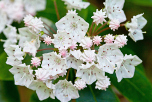
Boxwood
Buxus sempervirens
Boxwood shrubs are common bushes used for landscaping. They have tiny foliage and a dense texture, which makes it good as a landscape plant. It can be pruned into any desired shape.
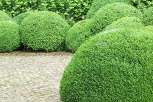
Black Chokeberry
Aronia melanocarpa Michx.
This is a woody shrub, which grows 3-6' high with the same width. This shrub gets shiny pendulous clusters of black berries, and has lustrous green leaves, and the flowers are white-pink in color, which grow in loose clusters.
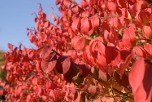
Burning Bush
Euonymus alata
Burning bush is hard to miss plant, as it gets bright red foliage during the autumn. It also bears reddish-orange berries during autumn. It can grow over 15 feet tall, and so needs to be pruned regularly.

Japanese Barberry
Berberis thunbergii
This is a dense deciduous shrub, that has deeply grooved brown, spiny branches which have a single spine at each shoot note. The leaves of this shrub are oval-shaped and very small, and the flowers are pale yellow, which produce edible glossy bright red berries, that contain a single seed.
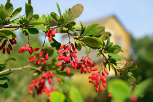
Red Rum Honeysuckle
Lonicera maackii
This is a deciduous shrub which grows to a height of 8-12'. It produces lots of white flowers which mature to yellow followed by bright red fruits throughout the winter.
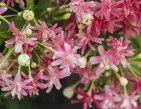
Common Spice Bush
Lindera benzoin
This is a 5-20 feet tall shrub which is a native to the laurel family. It has smooth-edged, oval and pointed alternate leaves which are oblong. It gets red berries, and when you crush the twigs or any part of this bush you will get a lemony-spicy smell.
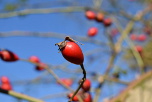
Variegated Yucca
Yucca filamentosa
This plant has greenish-blue leaves, which have white margins. During winter, the leaves get a tinge of pink. This evergreen shrub is slow-growing and forms massive tufts of foliage up to 30 inches, and it gets large white flowers which are edible.
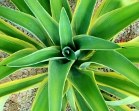
Crape Myrtle
Lagerstroemia
This is one of the longest blooming tree, which grows as short as 18 inches and as tall as 40 feet. It has smooth alternate leaves, and the flowers in summer are big showy cluster of pink, purple, lavender or red color. The fruits followed by the flowers are of brown or black color.
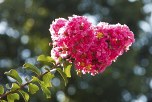
Redosier Dogwood
Cornus sericea
This species of dogwood, is a deciduous shrub, which grows 1.5-4 m tall, and 3-5 m wide. It branches and twigs are dark red, and the dark green leaves are opposite, and ovate to oblong shape. The flowers are small dull white, and appear in clusters, which are followed by white berries.
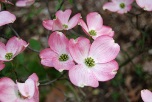
Hydrangea
Hydrangea
These are beautiful flowering plants, which get white, blue, pink, etc. colors of flowers in attractive clusters. These are small shrubs, which have large dark green leaves which are pointed.
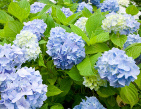
Privet
Ligustrum
Vulgare
This plant makes excellent tall and sound barriers, and has thick foliage which is dark green. It is a fast growing plant, and gets tiny white flowers.
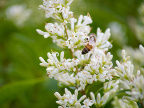
Viburnums
Viburnums
There are many species of viburnum, and the foliage can be rounded, lance-shaped or toothed, it can be velvety smooth or rough in texture. The flowers of viburnum shrubs are mostly white or pink in color, and often are fragrant.
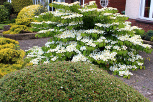
Leatherleaf Viburnum
Viburnum rhytidophyllum
These are large shrubs which can reach 10 feet height, and spread 6 feet or more. They have leathery leaves which are dark lustrous green, and are fuzzy gray below. These leaves droop limply from the stems. During late spring clusters of tiny white flowers can be seen, which are followed by oval red berries.
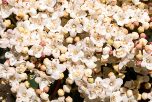
Azalea
Azaleas
These are flowering plants, which bloom in spring with big pinkish-white flowers. The plant has long bright green leaves, which are slender.
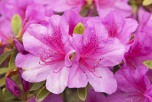 Identification of Evergreen Shrubs and Bushes
Identification of Evergreen Shrubs and Bushes
Given above chart shows various shrubs and bushes and their attributes. The first sign in evergreen shrub identification is that evergreen shrubs retain their leaves throughout the year. First scrutinize the leaves of the plant, conifers have needles or scales. Measure the length of the conifer needles, look at how many needles make a bundle. To check for angiosperms flowering plants, look at the configuration of the leaves along the branch. Check if they are paired oppositely, or alternate on the either side. Also, check how is the shape of the leaves, is origination from a single node. Is the shape of the leaf oblong, triangular, circular or lance like?
Rhododendron's plant has more bulbous, darker and rubbery leaves. Also, checking the bark can give you some hint, such as mountain laurel has a reddish-brown trunk, while of odorless bayberry is pale or white, the texture of mountain laurel is scaly while that of bayberry is smooth. Checking height can also give you some clues. Looking at the reproductive features can also give you some hints, flowers and seed are often flashy of evergreen shrubs and bushes.
Identification of Flowering Shrubs and Bushes
There are various types of flowering plants, here are some hints on guessing some of the popular flowering bushes. To identify butterfly bushes, check the butterflies flock. This is a small bush which has colorful flowers which bloom in cone shape flowers. Azaleas get vibrant clusters of flowers, and the foliage stays green all the year. The flowers are tube like and come in variety of colors. Lilac bushes get fragrant purple, red or white colored flowers, which bloom during spring. The flowers are small in shape and bloom in clusters.
Tree Shrubs Identification
To identify tree shrubs you need time and experience, here are some tips that will help you to spot difference between deciduous and evergreen trees, shrubs and bushes. You can consider getting a horticulture guidebook, and look at the various tree shrubs and bushes pictures, to see if you can match the shrub which have in front of you with the one present in the guidebook. This will make the job of identifying different types of evergreen shrubs and deciduous shrubs easier.
Examine the leaves of the shrub, the deciduous shrubs lose their leaves during the fall, and many species can be identified due to their distinct leaf shape and color of the foliage. Evergreen trees leaves don't change color, and can be of different shapes like start shaped, elongated, oval or obtuse. Check out the flowers, many shrubs during spring produce variety of colors. Smell the leaves, certain trees have a specific scent like that of eucalyptus and cedar tree.
So, remember the above tips visit gardens, local nurseries, shrubs and bushes for sale stores, and other landscapes where you can see various types of shrubs and bushes, and look at them closely to identify them.






 Different shrubs and bushes are used for different purposes. Most popular are evergreen bushes, which provide a green foliage throughout the year. Then there are deciduous shrubs and bushes which provide a great fall foliage, which makes them popular among cultivars. Then there are everyone's favorite the flowering plant bushes, which produce beautiful blooms of various colors during the spring and fill up the garden with beautiful fragrance. Certain flowering bushes, produce cherries throughout a season, which adds up to their value. Also, some people like to plant tree shrubs in their landscapes. If you want to learn how to distinguish between these shrubs and bushes, then here are various shrubs and bushes identification chart and tips that will help.
Different shrubs and bushes are used for different purposes. Most popular are evergreen bushes, which provide a green foliage throughout the year. Then there are deciduous shrubs and bushes which provide a great fall foliage, which makes them popular among cultivars. Then there are everyone's favorite the flowering plant bushes, which produce beautiful blooms of various colors during the spring and fill up the garden with beautiful fragrance. Certain flowering bushes, produce cherries throughout a season, which adds up to their value. Also, some people like to plant tree shrubs in their landscapes. If you want to learn how to distinguish between these shrubs and bushes, then here are various shrubs and bushes identification chart and tips that will help. Purple Butterfly Bush
Buddleia davidii
These bushes get beautiful purple blooms, and have dark gray-green leaves which are large. The flower heads are of 6-8" with beautiful fragrance, these bushes attract butterflies, hummingbirds and other beneficial insects.
Purple Butterfly Bush
Buddleia davidii
These bushes get beautiful purple blooms, and have dark gray-green leaves which are large. The flower heads are of 6-8" with beautiful fragrance, these bushes attract butterflies, hummingbirds and other beneficial insects.
 Red Twig Dogwood
Cornus alba 'Elegantissima.'
This bush grows to a height of 8', and 8' width. It bears variegated leaves, which are greenish gray with a white edge, and has small white flowers which together form a flat cluster. The flowers then transform into berries which are white with hints of blue and green. During fall, it will get a rose or gold foliage.
Red Twig Dogwood
Cornus alba 'Elegantissima.'
This bush grows to a height of 8', and 8' width. It bears variegated leaves, which are greenish gray with a white edge, and has small white flowers which together form a flat cluster. The flowers then transform into berries which are white with hints of blue and green. During fall, it will get a rose or gold foliage.
 Common White Lilac
Syringa Vulgaris
Lilac bush is a beautiful and fragrant deciduous shrub, and can be used as a hedge. It gets white flowers in clusters and has dark green leaves which are heart-shaped.
Common White Lilac
Syringa Vulgaris
Lilac bush is a beautiful and fragrant deciduous shrub, and can be used as a hedge. It gets white flowers in clusters and has dark green leaves which are heart-shaped.

 Daphne Laurel
Daphne laureola
This evergreen shrub forms a plant, which looks like a small tree of 2-4 feet tall. It's leaves are densely whorled near the top of the stem, and are very dark green, shiny and smooth. The twigs have a stout odor when they are cut, and the flowers are small and grow in clusters of 2-10.
Daphne Laurel
Daphne laureola
This evergreen shrub forms a plant, which looks like a small tree of 2-4 feet tall. It's leaves are densely whorled near the top of the stem, and are very dark green, shiny and smooth. The twigs have a stout odor when they are cut, and the flowers are small and grow in clusters of 2-10.
 Mountain Laurel
Kalmia latifolia
For mountain laurel shrub identification, remember these attributes. This shrub is a broad leaf evergreen, which has deep green glossy leaves. During spring the shrub displays small pink and white flowers.
Mountain Laurel
Kalmia latifolia
For mountain laurel shrub identification, remember these attributes. This shrub is a broad leaf evergreen, which has deep green glossy leaves. During spring the shrub displays small pink and white flowers.
 Boxwood
Buxus sempervirens
Boxwood shrubs are common bushes used for landscaping. They have tiny foliage and a dense texture, which makes it good as a landscape plant. It can be pruned into any desired shape.
Boxwood
Buxus sempervirens
Boxwood shrubs are common bushes used for landscaping. They have tiny foliage and a dense texture, which makes it good as a landscape plant. It can be pruned into any desired shape.
 Black Chokeberry
Aronia melanocarpa Michx.
This is a woody shrub, which grows 3-6' high with the same width. This shrub gets shiny pendulous clusters of black berries, and has lustrous green leaves, and the flowers are white-pink in color, which grow in loose clusters.
Black Chokeberry
Aronia melanocarpa Michx.
This is a woody shrub, which grows 3-6' high with the same width. This shrub gets shiny pendulous clusters of black berries, and has lustrous green leaves, and the flowers are white-pink in color, which grow in loose clusters.
 Burning Bush
Euonymus alata
Burning bush is hard to miss plant, as it gets bright red foliage during the autumn. It also bears reddish-orange berries during autumn. It can grow over 15 feet tall, and so needs to be pruned regularly.
Burning Bush
Euonymus alata
Burning bush is hard to miss plant, as it gets bright red foliage during the autumn. It also bears reddish-orange berries during autumn. It can grow over 15 feet tall, and so needs to be pruned regularly.
 Japanese Barberry
Berberis thunbergii
This is a dense deciduous shrub, that has deeply grooved brown, spiny branches which have a single spine at each shoot note. The leaves of this shrub are oval-shaped and very small, and the flowers are pale yellow, which produce edible glossy bright red berries, that contain a single seed.
Japanese Barberry
Berberis thunbergii
This is a dense deciduous shrub, that has deeply grooved brown, spiny branches which have a single spine at each shoot note. The leaves of this shrub are oval-shaped and very small, and the flowers are pale yellow, which produce edible glossy bright red berries, that contain a single seed.
 Red Rum Honeysuckle
Lonicera maackii
This is a deciduous shrub which grows to a height of 8-12'. It produces lots of white flowers which mature to yellow followed by bright red fruits throughout the winter.
Red Rum Honeysuckle
Lonicera maackii
This is a deciduous shrub which grows to a height of 8-12'. It produces lots of white flowers which mature to yellow followed by bright red fruits throughout the winter.

 Variegated Yucca
Yucca filamentosa
This plant has greenish-blue leaves, which have white margins. During winter, the leaves get a tinge of pink. This evergreen shrub is slow-growing and forms massive tufts of foliage up to 30 inches, and it gets large white flowers which are edible.
Variegated Yucca
Yucca filamentosa
This plant has greenish-blue leaves, which have white margins. During winter, the leaves get a tinge of pink. This evergreen shrub is slow-growing and forms massive tufts of foliage up to 30 inches, and it gets large white flowers which are edible.

 Redosier Dogwood
Cornus sericea
This species of dogwood, is a deciduous shrub, which grows 1.5-4 m tall, and 3-5 m wide. It branches and twigs are dark red, and the dark green leaves are opposite, and ovate to oblong shape. The flowers are small dull white, and appear in clusters, which are followed by white berries.
Redosier Dogwood
Cornus sericea
This species of dogwood, is a deciduous shrub, which grows 1.5-4 m tall, and 3-5 m wide. It branches and twigs are dark red, and the dark green leaves are opposite, and ovate to oblong shape. The flowers are small dull white, and appear in clusters, which are followed by white berries.
 Hydrangea
Hydrangea
These are beautiful flowering plants, which get white, blue, pink, etc. colors of flowers in attractive clusters. These are small shrubs, which have large dark green leaves which are pointed.
Hydrangea
Hydrangea
These are beautiful flowering plants, which get white, blue, pink, etc. colors of flowers in attractive clusters. These are small shrubs, which have large dark green leaves which are pointed.



 Azalea
Azaleas
These are flowering plants, which bloom in spring with big pinkish-white flowers. The plant has long bright green leaves, which are slender.
Azalea
Azaleas
These are flowering plants, which bloom in spring with big pinkish-white flowers. The plant has long bright green leaves, which are slender.
